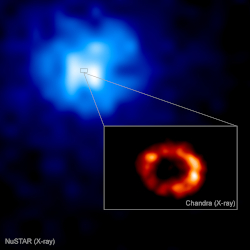 HEAPOW: A 34-Year-Old Neutron Star (2021 Mar 01)
HEAPOW: A 34-Year-Old Neutron Star (2021 Mar 01)
Thirty four years ago, on February 23, 1987, the world was shaken by the explosion of a massive blue star in the Large Magellanic Cloud, one of the more massive of the Milky Way's current set of satellite galaxies. This was the nearest such star explosion seen in over 400 years. The LMC lies at a distance of 170,000 lightyears from earth, so that the actual explosion took place about 170,000 years before 1987. This event was a real watershed, the first opportunity to study, with with modern astronomical instruments, the details of a "core collapse" supernova, an unbelievably powerful stellar explosion produced by the formation of an iron core at the center of a massive star. This explosion produced, for a short while, about as much radiation as the rest of the LMC, and even produced a burst of sub-atomic neutrinos, which was detected on earth, helping to usher in a new era of "multi-messenger" astrophysics and confirm theories of core-collapse supernovae. Since 1987, astronomers have been monitoring the evolution of the shock of radiation and matter produced in the explosion. In addition to producing an extended, hot glowing supernova remnant, core-collapse supernovae are expected to leave behind the dead core of the progenitor star, an ultradense neutron star or a singular black hole, but despite more than 30 years of careful study, this collapsed object has frustratingly escaped detection. Until, perhaps, this year. Using archived X-ray images of SN 1987A, and other data, from the Chandra X-ray Observatory and the NuSTAR high energy X-ray observatory, astronomers believe they have detected the first clue of the presence of the collapsed stellar core. The NuSTAR image, in blue above, shows extended high energy emission from SN 1987A, while Chandra, with its high resolution cameras, details the extended ring of hot gas produced by the ejecta from the explosion, stretching about a lightyear in all directions. Comparison of the X-ray data from NuSTAR and Chandra reveal unusual energy emission which is believed to be produced by the magnetically-driven wind from a tiny, newborn neutron star near the center of the X-ray emitting ring. This provides an exquisite opportunity to examine the properties of a new neutron star, and to see how it will cool and evolve with time over the next few centuries, and beyond.
CXC: SN 1987A: Reclusive Neutron Star May Have Been Found in Famous Supernova
| << Previous HEAPOW | High Energy Astrophysics Picture of the Week | Next HEAPOW >> |
